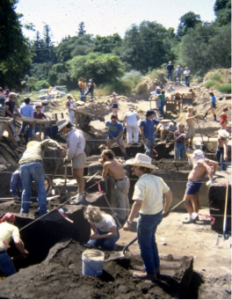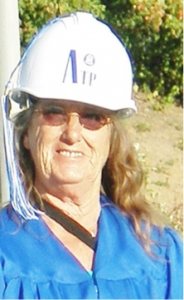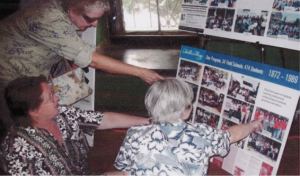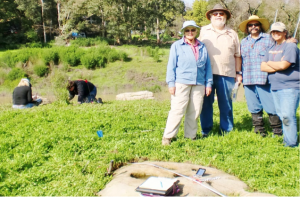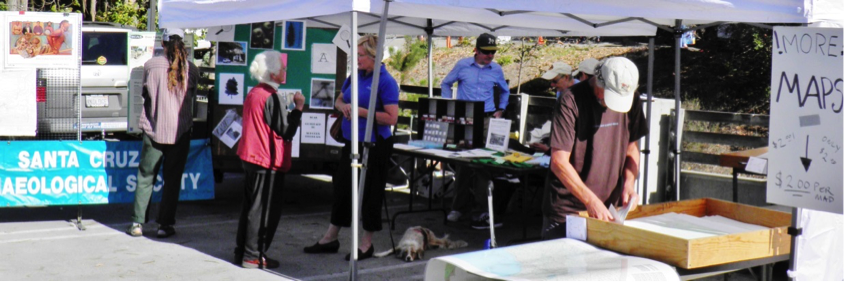By Rob Edwards
This is a question I have received many times over the years both from the public and from newer members. The following is a response after some consideration of the role and the history of the Society in our community.
The Santa Cruz Archaeological Society (SCAS) was started in 1972 and has been continuously active for over 44 years. In its first two years the Society grew to over 50 members, almost all of whom had taken at least one class in Introductory Archaeology from Cabrillo College, and many had had a Field Class experience as well. They came with a fascination for archaeology and with deep ties to our community. The impact of these “community archaeologists” over the years has been extensive. Members have been active in public education by creating local Indian and archaeological school kits that the local museums could lend out to schools; preparing exhibits for our County Fair (First place Ribbon Santa Cruz County Fair, see Awards Photos) and for various Historic Heritage Days; making class visits to elementary schools to teach about how archaeology is done and what it has taught us.
Society members have persistently worked with local land owners to preserve historic and prehistoric sites including assisting in the salvage and saving of the 2,500 BCE site (CA-SCR-20, 1972–74) in Bonny Doon (see Field School Photos; 1972, 1995, 2000, and 2005). They have carried out volunteer salvage in the Watsonville area in 1974–75 at Lee Road where a prehistoric burial site was being destroyed, and at the St. Francis Cemetery. SCAS members volunteered their energy for the salvage and processing of prehistoric lithic materials from CA-SCR-35 in Davenport in 1978. They also supported the salvage and processing of materials from the Branciforte Adobe and at the Sunflower House in Santa Cruz. The Society also assisted in the preservation of the Dutton Adobe in south Monterey County (see Awards Photos).
It was this same local Archaeological Society that arranged (beginning January 1975) the contract with the County Planning Department to do initial (presence/absence) archaeological surveys for local construction permits and continued that service for over 30 years. All told, SCAS members carried out over 1,000 volunteer surveys that increased the County’s capacity to surpass CEQA requirements while reducing the cost to local land owners. In addition to SCAS’s long relationship with the County Planning Department, members have done volunteer surveys for the cities of Santa Cruz and Capitola.
In the early 1980s, in response to major development in the area of the old Santa Cruz Mission, SCAS, under the guidance of the Cabrillo College Archaeology Program, carried out several years of unfunded “salvage” excavations at the site of the old adobe on Mission Hill. The Santa Cruz Archaeological Society members worked with the local historic community (members of the Adobe Coalition) to change how the City handled development on Mission Hill and indeed in the City as a whole (see Field School Photos 1981–86).
SCAS members contributed financial support to this effort and also helped write both a historic and a prehistoric ordinance. In the years just prior to the bicentennial celebration of Santa Cruz’s founding in 1991, SCAS was visibly and effectively active in the public education projects in public venues such as Fiesta Days, County Fairs, and in the schools.
In 1981 a major, significant, and very early prehistoric site was deliberately destroyed by the city of Scotts Valley. The Archaeology Society led the way in a legal suit to attempt to preserve what was already heavily impacted site at Scotts Valley City Hall and to force the city to comply with environmental law. When there was no alternative, the Society membership joined together with the local historic community including the Scotts Valley Historical Society and the statewide Society for California Archaeology, to provide leadership, raise funds, and carry out a campaign of education and political action. They finally went to court in legal battles against that local municipality. It was the history of involvement and commitment to local heritage that led to the Society being recognized by the local courts as a stake holder in local cultural resources in this case.
Those battles lasted over three years, (1981–84) and were finally concluded by the Society accepting an out of court settlement from the City of Scotts Valley of over $25,000. The Society went on to organize one of the largest volunteer “events” for an amazing large scale “salvage” effort in 1983. Archaeological volunteers came from across the State to help in this project. There were more than 125 people a day involved over a four day period. Photos below picture the large group excavation and coordinators Charlene Duval, Jennise Singer, Charr Smith, and Kate Harper. The Society received several recognitions for this and other volunteerism (see Awards Photos).
Due in a great part to the high visibility of the archaeological activities in the 1980s and the awareness of the archaeological interest from the local community, in the early 1990’s the “vocational” Cabrillo College Archaeological Technology Program was created. Santa Cruz Archaeological Society members were among the first to go through the training, receive certificates, provide scholarships for other students, and support the program financially. (Below: Judi Cole, and longtime SCAS members finding their photos on a Poster.)
As part of this training, students worked on many local cooperative projects: in Monterey County (U.S. Forest Service, 1991–94 and private consultant 1992); in Santa Cruz County, at a number of projects including in Watsonville at the Redman-Hirahara House (2005); in San Mateo County (CA State Parks and Bureau of Land Management 1993, 1995, 2000, and 2008); at various State Parks and Año Nuevo State Park (2001, 2002, 2003, and 2004) and at the San Francisco Presidio with both the National Park Service (1996–97) and the Presidio Trust (1998–99 and again in 2006–07). (See Field School Photos 1990–2008.)
All these “local” projects allowed students the ability to attend and receive accessible and inexpensive professional training. Many of these students became members of the Santa Cruz Archaeological Society and contributed to its success.
About 40% of Cabrillo’s “Arche Tech” students continued on to four-year schools, or, those with BA’s, on to graduate school. Still others obtained and went to work in private businesses (including local cultural resources management firms) or with governmental agencies. At the SCA meetings in San Jose, about 10% of attendees wore “Blue Alumni Badges.” The other Arche Tech Program graduates have taken their interests and knowledge into their lives and their communities. (See Lexington Survey photo below.)
I have been fortunate to have taught in one community college for almost all of my 40+ years of teaching and therefore have had the opportunity to see some of these local community contributions that I think may be unseen by those with less time in one place. These students, many of whom are SCAS members, have provided energy and expertise to support the archaeological needs in their communities. They were the backbone of political support for archeology at public meetings, for appropriate legislation, for public education at county fairs and in the schools and at community heritage celebrations. The volunteer survey contract with the Santa Cruz Planning Department continued through 2005.
Society members continue to do outreach in the community such as the Map Sales at a local public farmers’ market, participation at the Santa Cruz Mission Adobe, and maintaining what has to be one of the longest continuous archaeological lecture series in the State.
These community-based archeologists are true life-long learners and important contributors to Santa Cruz. They are also the energy of the Santa Cruz Archaeological Society and the major reason for the awareness of and interest in archaeology in our local community.

